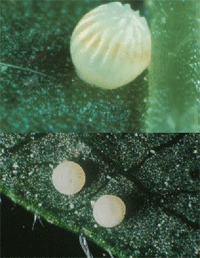The past two weeks have been pretty busy around the extension office. I've been to so many different field days, and gotten to look at a bunch of different trials and varieties. I have also eaten close to my body weight in barbeque within the last two weeks. Thank you to everyone that invited me and the other extension agents to your field days, I learned a lot and appreciated the opportunity to meet people.
 |
| H. zea moth in Cotton Photo: Kate Harrell |
 |
| H. zea caterpillar Photo: Kate Harrell |
 |
| H. zea caterpillar Photo: Kate Harrell |
There have been some stinkbugs around, and there is damage in fields from both stinkbugs and Lygus bugs. These insects are highly mobile, which can make them difficult to pick up. The threshold for stinkbugs in cotton is 20% dropped bolls or bolls with warts on inner carpal walls or stained lint and finding stinkbugs in the field using a drop cloth.
 |
| Stinkbug eggs found on the underside of a cotton leaf Photo: Kate Harrell |
 |
| Stinkbug Nymph Photo: Kate Harrell |
Fall armyworms are moving into sorghum now as well. If sorghum has yet to head out and is still in the whorl stage, treatment for either H. zea (bollworm, earworm, etc.) or fall armyworm is only advised if the leaf area is being reduced by at least 30% or the growing point is being damaged. The "shotgun shot" appearance of the armyworm feeding is dramatic, but often not a problem if the head or growth point is not at risk. If the sorghum already has a head on it, you will want to use a beat bucket to sample for caterpillars. Follow this link for the sorghum headworm threshold calculator: http://bug.tamu.edu/apps/sorghumheadwormcalculator/index.php
 |
| Fall Armyworm Photo: Kate Harrell |
Note the inverted Y on the face of the armyworm larvae (photo on left), as well as the perfect square of black dots on the rear (photo on lower left). Be sure to check on aphid populations and carefully consider treatment options before spraying for headworms in sorghum. Wiping out beneficial insect populations with a spray for caterpillars will flare sugarcane aphids.
 |
| Fall Armyworm Photo: Kate Harrell |
Continue to keep an eye on sugarcane aphid populations, they have gotten high in places and needed treatment. The threshold is 50-125 aphids per leaf, treat within 4 days of reaching threshold. As we get closer to harvest it will be more important to keep and eye on their numbers. As many of you have seen in the past, the honeydew produced by these aphids along with the sooty mildew that tends to grow on it can really gunk up a combine if their populations get too high.
 |
| Southern Rust in Corn Photo: Kate Harrell |
 |
| Southern Rust in Corn Photo: Kate Harrell |
Dr. Isakeit, our plant pathology specialist, was out in Wharton county recently. He took the time to walk through some of the diseases in our corn right now. Southern rust is out in force right now, and if you are debating whether or not to make a treatment on I encourage you to check out this publication Dr. Isakeit put together: http://aglifesciences.tamu.edu/plantpathology/wp-content/uploads/sites/19/2011/05/Southern-Rust-of-Corn_2014.pdf
If you have any questions or concerns, please don't hesitate to call me. Have a great weekend, everyone.
Kate














